TP-Link 1910010933 User Manual
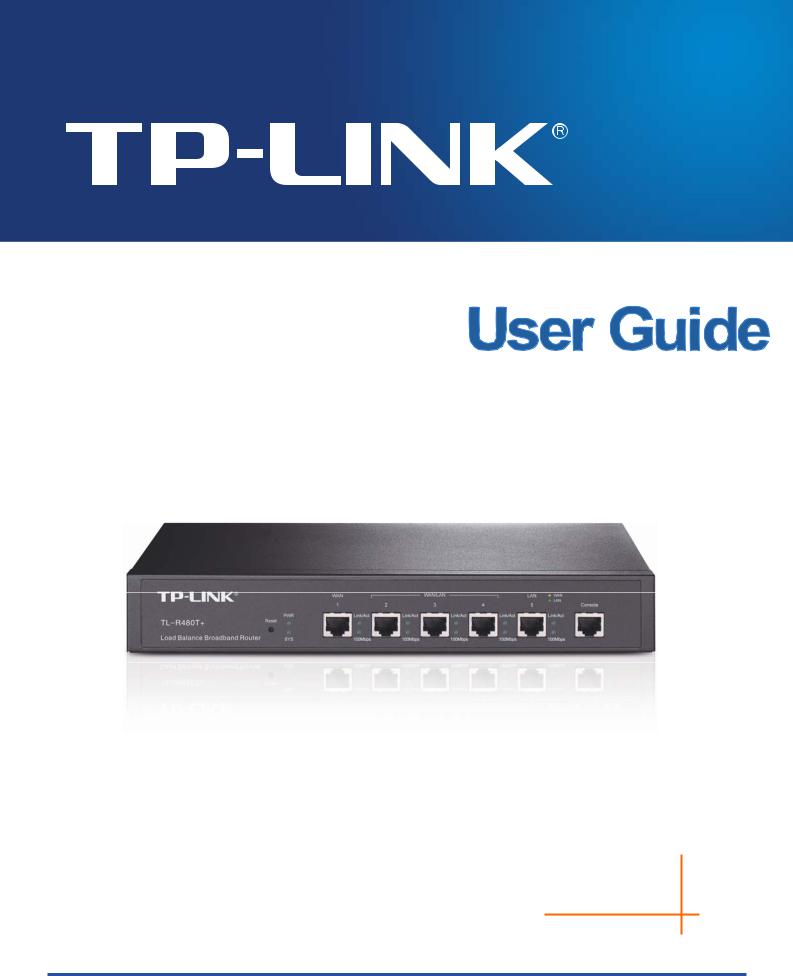
TL-R480T+
Load Balance Broadband Router
REV6.0.0
1910010933

COPYRIGHT & TRADEMARKS
Specifications are subject to change without notice.  is a registered trademark of TP-LINK TECHNOLOGIES CO., LTD. Other brands and product names are trademarks of their respective holders.
is a registered trademark of TP-LINK TECHNOLOGIES CO., LTD. Other brands and product names are trademarks of their respective holders.
No part of the specifications may be reproduced in any form or by any means or used to make any derivative such as translation, transformation, or adaptation without permission from TP-LINK TECHNOLOGIES CO., LTD. Copyright © 2013 TP-LINK TECHNOLOGIES CO., LTD. All rights reserved.
http://www.tp-link.com
FCC STATEMENT
This equipment has been tested and found to comply with the limits for a Class A digital device, pursuant to part 15 of the FCC Rules. These limits are designed to provide reasonable protection against harmful interference when the equipment is operated in a commercial environment. This equipment generates, uses, and can radiate radio frequency energy and, if not installed and used in accordance with the instruction manual, may cause harmful interference to radio communications. Operation of this equipment in a residential area is likely to cause harmful interference in which case the user will be required to correct the interference at his own expense.
This device complies with part 15 of the FCC Rules. Operation is subject to the following two conditions:
1)This device may not cause harmful interference.
2)This device must accept any interference received, including interference that may cause undesired operation.
Any changes or modifications not expressly approved by the party responsible for compliance could void the user’s authority to operate the equipment.
CE Mark Warning
This is a class A product. In a domestic environment, this product may cause radio interference, in which case the user may be required to take adequate measures.
-I-

Продукт сертифіковано згідно с правилами системи УкрСЕПРО на відповідність вимогам нормативних документів та вимогам, що передбачені чинними законодавчими актами України.
Safety Information
zWhen product has power button, the power button is one of the way to shut off the product; When there is no power button, the only way to completely shut off power is to disconnect the product or the power adapter from the power source.
zDon’t disassemble the product, or make repairs yourself. You run the risk of electric shock and voiding the limited warranty. If you need service, please contact us.
zAvoid water and wet locations.
●
●
●
●
●
●
採取某些適當的對策。
This product can be used in the following countries:
AT |
BG |
BY |
CA |
CZ |
DE |
DK |
EE |
|
|
|
|
|
|
|
|
ES |
FI |
FR |
GB |
GR |
HU |
IE |
IT |
|
|
|
|
|
|
|
|
LT |
LV |
MT |
NL |
NO |
PL |
PT |
RO |
|
|
|
|
|
|
|
|
RU |
SE |
SK |
TR |
UA |
|
|
|
|
|
|
|
|
|
|
|
-II-
|
|
|
CONTENTS |
Package Contents.................................................................................................................. |
1 |
||
Chapter 1 About this Guide ................................................................................................... |
2 |
||
1.1 |
Intended Readers .................................................................................................................. |
2 |
|
1.2 |
Conventions ........................................................................................................................... |
2 |
|
1.3 |
Overview of this Guide........................................................................................................... |
2 |
|
Chapter 2 Introduction .......................................................................................................... |
4 |
||
2.1 |
Overview of the Router .......................................................................................................... |
4 |
|
2.2 |
Features................................................................................................................................. |
5 |
|
2.3 |
Appearance............................................................................................................................ |
6 |
|
|
2.3.1 |
Front Panel ................................................................................................................ |
6 |
|
2.3.2 |
Rear Panel................................................................................................................. |
7 |
Chapter 3 Quick Installation Guide......................................................................................... |
8 |
||
3.1 |
Configure PC ......................................................................................................................... |
8 |
|
3.2 |
Login .................................................................................................................................... |
|
11 |
Chapter 4 Configuration ...................................................................................................... |
17 |
||
4.1 |
Status ................................................................................................................................... |
|
17 |
4.2 |
Quick Setup ......................................................................................................................... |
18 |
|
4.3 |
Network................................................................................................................................ |
18 |
|
|
4.3.1 |
WAN ........................................................................................................................ |
18 |
|
4.3.2 |
LAN.......................................................................................................................... |
35 |
|
4.3.3 |
MAC Address........................................................................................................... |
39 |
|
4.3.4 |
Switch ...................................................................................................................... |
40 |
4.4 |
User Group .......................................................................................................................... |
46 |
|
|
4.4.1 |
Group....................................................................................................................... |
47 |
|
4.4.2 |
User ......................................................................................................................... |
47 |
|
4.4.3 |
View......................................................................................................................... |
48 |
4.5 |
Advanced ............................................................................................................................. |
49 |
|
|
|
|
-III- |
|
4.5.1 |
NAT.......................................................................................................................... |
49 |
|
4.5.2 |
Traffic Control .......................................................................................................... |
58 |
|
4.5.3 |
Session Limit ........................................................................................................... |
62 |
|
4.5.4 |
Load Balance........................................................................................................... |
63 |
|
4.5.5 |
Routing .................................................................................................................... |
68 |
4.6 |
Firewall................................................................................................................................. |
71 |
|
|
4.6.1 |
Anti ARP Spoofing ................................................................................................... |
71 |
|
4.6.2 |
Attack Defense ........................................................................................................ |
74 |
|
4.6.3 |
MAC Filtering ........................................................................................................... |
76 |
|
4.6.4 |
Access Control......................................................................................................... |
77 |
|
4.6.5 |
App Control.............................................................................................................. |
83 |
4.7 |
Services ............................................................................................................................... |
85 |
|
|
4.7.1 |
PPPoE Server.......................................................................................................... |
85 |
|
4.7.2 |
E-Bulletin ................................................................................................................. |
91 |
|
4.7.3 |
Dynamic DNS .......................................................................................................... |
92 |
|
4.7.4 |
UPnP ....................................................................................................................... |
98 |
4.8 |
Maintenance ...................................................................................................................... |
100 |
|
|
4.8.1 |
Admin Setup .......................................................................................................... |
100 |
|
4.8.2 |
Management.......................................................................................................... |
103 |
|
4.8.3 |
Statistics................................................................................................................. |
105 |
|
4.8.4 |
Diagnostics ............................................................................................................ |
107 |
|
4.8.5 |
Time....................................................................................................................... |
109 |
|
4.8.6 |
Logs....................................................................................................................... |
111 |
Appendix A |
Hardware Specifications ........................................................................... |
113 |
|
Appendix B |
FAQ ......................................................................................................... |
114 |
|
Appendix C |
Glossary .................................................................................................. |
116 |
|
-IV-

Package Contents
The following items should be found in your package:
¾One TL-R480T+ Load Balance Broadband Router
¾One Power cord
¾One Console Cable
¾One Ethernet Cable
¾Quick Installation Guide
¾Mounting kits for installing in a standard 19-inch rack
¾Resource CD
 Note:
Note:
●Make sure that the package contains the above items. If any of the listed items are damaged or missing, please contact with your distributor.
●The provided power cord may be different due to local power specifications.
-1-

Chapter 1 About this Guide
This User Guide contains information for setup and management of TL-R480T+ Load Balance Broadband Router. Please read this guide carefully before operation.
1.1 Intended Readers
This Guide is intended for Network Engineer and Network Administrator.
1.2 Conventions
In this Guide the following conventions are used:
¾The router or TL-R480T+ mentioned in this Guide stands for TL-R480T+ Load Balance Broadband Router without any explanation.
¾Menu Name→Submenu Name→Tab page indicates the menu structure. Advanced→NAT
→Basic NAT means the Basic NAT page under the NAT menu option that is located under the Advanced menu.
¾Bold font indicates a toolbar icon, menu or menu item.
¾<Font> indicate a button.
Symbols in this Guide:
|
Symbol |
Description |
|
|
|
|
Note: |
Ignoring this type of note might result in a malfunction or damage to the |
|
device. |
|
|
|
|
|
Tips: |
This format indicates important information that helps you make better use of |
|
your device. |
|
|
|
|
1.3 Overview of this Guide
Chapter 1 About This Guide |
Introduces the guide structure and conventions. |
|
Chapter 2 |
Introduction |
Introduces the features and appearance of TL-R480T+ router. |
Chapter 3 |
Quick Installation Guide |
Introduces how to log in and set up the router. |
Chapter 4 |
Configuration |
Introduces how to configure the router via Web management page. |
Appendix A Hardware |
Lists the hardware specifications of this router. |
|
Specifications |
|
|
-2-
Appendix B FAQ |
Provides the possible solutions to the problems that may occur during |
|
the installation and operation of the router. |
Appendix C Glossary |
Lists the glossary used in this guide. |
-3-
Chapter 2 Introduction
Thanks for choosing the Load Balance Broadband Router TL-R480T+.
2.1 Overview of the Router
The Load Balance Broadband Router TL-R480T+ from TP-LINK possesses excellent data processing capability and multiple powerful functions including Load Balance, Access Control, Bandwidth Control, Session Limit, PPPoE Server and so on, which consumedly meet the needs of small and medium enterprises, hotels and communities with volumes of users demanding an efficient and easy-to-manage network with high security.
zPowerful Data Processing Capability
+Built-in MIPS32 network processor and 64MB DDR high-speed RAM guarantee the stability and reliability for operation.
zOnline Behavior Management
+Complete Functions of Access Rules can allow managers to select the network service levels to block or allow applications of FTP downloading, Email, Web browsing and so on.
+Deploying One-Click restricting of applications to save time & energy.
+Supporting URL Filtering to prevent potential hazards from visiting the malicious Web sites.
zPowerful Firewall
+Supporting One-Click IP-MAC Binding to avoid ARP spoofing and guarantee a network without stagnation.
+Featured Attack Defense to protect the network from a variety of flood attack and packet anomaly attack.
+Possessing MAC Filtering function to block the access of illegal hosts.
zFlexible Traffic Control
+Featured Bandwidth Control with flexible bandwidth management to automatically control the bandwidth of the host in bi-direction to avoid bandwidth over occupation, as well as optimize bandwidth usage.
+Supporting Session Limit to avoid the complaint of a few people to force whole sessions.
zMulti-WAN Ports
+Providing three adjustable WAN/LAN ports for users to configure the amount of WAN ports based on need and connect multiple Internet lines for bandwidth expansion.
+Supporting multiple Load Balance modes, including Bandwidth Based Balance Routing, Application Optimized Routing, and Policy Routing to optimize bandwidth usage.
-4-
+ Featured Link Backup to switch all the new sessions from dropped line automatically to another for keeping an always on-line network.
zEasy-to-use
+Providing easy-to-use GUI with clear configuration steps and detailed help information for the users to configure the router simply.
+Helping administrators to monitor the whole network status and take actions to malfunctions according to the recorded log information.
+Supporting remote management to manage the router from remote places.
2.2 Features
Hardware
¾1 fixed WAN port (port 1), 3 adjustable WAN/LAN ports, 1 fixed LAN port (port 5) and 1 Console port
¾Built-in high-quality power supply with non-fan system design for quietness
¾Possesses standard-sized, 19-inch outfit for standard rack
¾Supports Professional 4kV common mode lightning protection
¾Complies with IEEE 802.3, IEEE 802.3u
¾Supports TCP/IP, DHCP, ICMP, NAT, NAPT protocols
¾Supports PPPoE, SNTP, HTTP, DDNS, UPnP, NTP protocols
Basic Functions
¾Supports Static IP, Dynamic IP, PPPoE/Russian PPPoE, L2TP/Russian L2TP, PPTP/Russian PPTP, Dual Access, BigPond Internet connections
¾Supports Virtual Server, Port Triggering, ALG, Static Route
¾Built-in Switch supporting Port Mirror, Port VLAN, Rate Control and so on
¾Supports to change the MAC address of LAN and WAN ports
¾Supports PPPoE Server and E-Bulletin
¾Supports Logs, Statistics, Time setting
¾Supports Remote and Web management
¾Supports Diagnostic (Ping/Tracert) and Online Detection
Traffic Control
¾Supports Bandwidth Control
¾Supports Session Limit
-5-

Security
¾Built-in firewall supporting URL/MAC Filtering
¾Supports Access Control
¾Supports App Control
¾Supports Attack Defense
¾Supports IP-MAC Binding
¾Supports GARP (Gratuitous ARP)
2.3 Appearance
2.3.1 Front Panel
The front panel of TL-R480T+ is shown as the following figure.
z LEDs
LED |
|
Status |
|
Indication |
PWR |
|
On |
|
The router is powered on. |
|
|
|
|
|
|
|
Off |
The router is powered off or power supply is abnormal. |
|
|
|
|
|
|
SYS |
|
Flashing |
The router works properly. |
|
|
|
|
|
|
|
|
On/Off |
The router works improperly. |
|
|
|
|
|
|
|
|
Off |
There is no device linked to the corresponding port. |
|
|
|
|
|
|
|
|
|
|
There is a device linked to the corresponding port but no |
Link/Act |
|
On (Green/Yellow) |
|
activity. (Green light indicates the corresponding port is |
|
|
|
working as a LAN port, and yellow indicates WAN port.) |
|
(WAN/LAN) |
|
|
|
|
|
|
|
|
|
|
|
Flashing |
|
There is an active device linked to the corresponding port. |
|
|
|
(Green light indicates the corresponding port is working as a |
|
|
|
(Green/Yellow) |
|
|
|
|
|
LAN port, and yellow indicates WAN port.) |
|
|
|
|
|
|
|
|
|
|
|
|
|
Off |
|
The linked device is running at 10Mbps. |
100Mbps |
|
|
|
|
|
|
|
The linked device is running at 100Mbps. (Green light |
|
(WAN/LAN) |
|
|
|
|
|
On (Green/Yellow) |
|
indicates the corresponding port is working as a LAN port, and |
|
|
|
|
|
yellow indicates WAN port.) |
|
|
|
|
|
|
|
|
-6- |
|
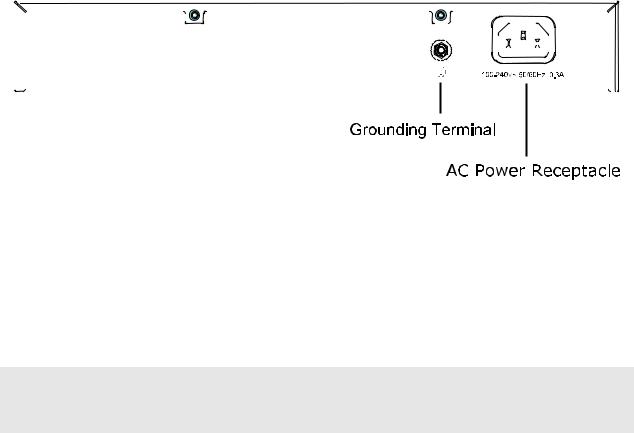
zInterface Description
|
Interface |
Port |
|
Description |
|
WAN |
1~4 |
|
The WAN port is for connecting the router to a DSL/Cable |
|
|
modem or Ethernet by the RJ45 cable. |
||
|
|
|
|
|
|
|
|
|
|
|
LAN |
2~5 |
|
The LAN port is for connecting the router to the local PCs or |
|
|
switches by the RJ45 cable. |
||
|
|
|
|
|
|
|
|
|
|
|
Console |
/ |
|
The Console port is for connecting with the serial port of a |
|
|
computer or terminal to monitor and configure the router. |
||
|
|
|
|
|
|
|
|
|
|
zReset button
Use the button to restore the router to the factory defaults. With the router powered on, use a pin to press and hold the Reset button (about 5 seconds). If the SYS LED is flashing 5 times in high frequency, release the Reset button. It means the router is restored successfully. The default management address of the router is http://192.168.0.1, and the default username and the password are both admin.
2.3.2 Rear Panel
The rear panel of TL-R480T+ is shown as the following figure.
zAC Power Receptacle
Connect the female connector of the power cord to this power receptacle, and the male connector to the AC power outlet. Please make sure the voltage of the power supply meets the requirement of the input voltage (100-240V~ 50/60Hz).
zGrounding Terminal
The router already comes with lightning protection mechanism. You can also ground the router through the PE (Protecting Earth) cable of AC cord or with Ground Cable.
 Note:
Note:
Please only use the power cord provided with this router.
-7-
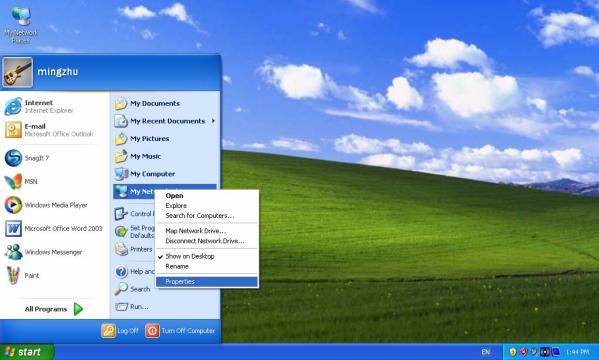
Chapter 3 Quick Installation Guide
After connecting the TL-R480T+ router into your network, you should configure it. This chapter describes how to configure the basic functions of your TL-R480T+ Load Balance Broadband Router. These procedures only take you a few minutes. You can access the Internet via the router immediately after it has been successfully configured.
3.1 Configure PC
Step 1: Click the Start menu on your desktop, right click My Network Places, and then select Properties (shown in Figure 3-1).
Figure 3-1
-8-
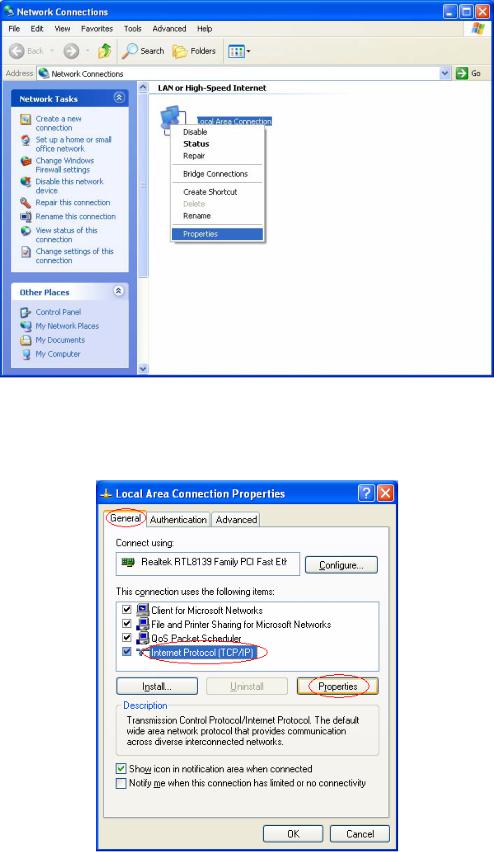
Step 2: In the next screen, right click Local Area Connection (LAN), and then select Properties.
Figure 3-2
Step 3: In the next screen, select General tab, highlight Internet Protocol (TCP/IP), and then click the
Properties button.
Figure 3-3
-9-
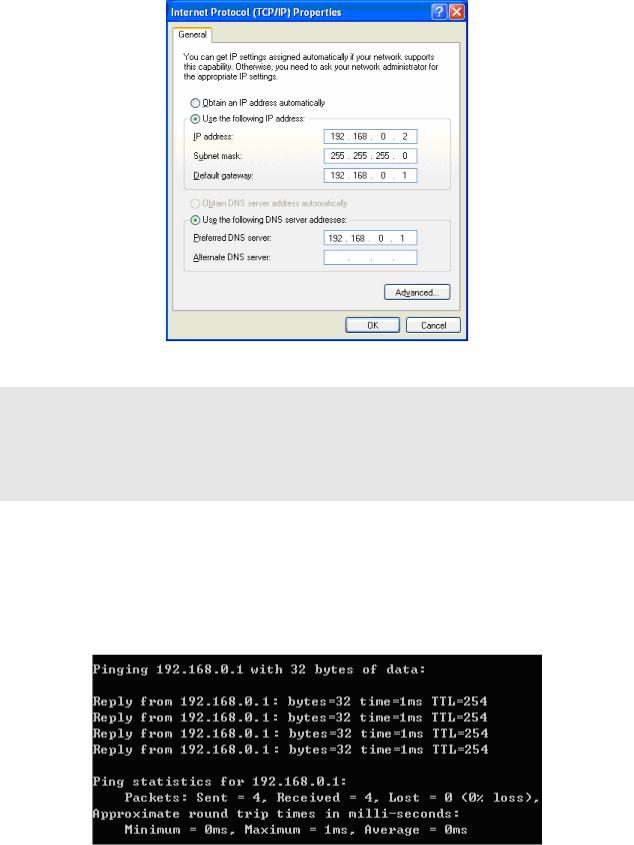
Step 4: Configure the IP address as shown in Figure 3-4. After that, click OK.
Figure 3-4
 Note:
Note:
You can configure the PC to get an IP address automatically, select “Obtain an IP address automatically” and “Obtain DNS server address automatically” in the screen above. For Windows 98 OS or earlier, the PC and router may need to be restarted.
Now, you can run the Ping command in the command prompt to verify the network connection. Please click the Start menu on your desktop, select run tab, type cmd in the field, and then type ping 192.168.0.1 on the next screen, and then press Enter.
If the result displayed is similar to the screen below, the connection between your PC and the router has been established.
Figure 3-5
If the result displayed is similar to the screen shown below, it means that your PC has not connected to the router.
-10-
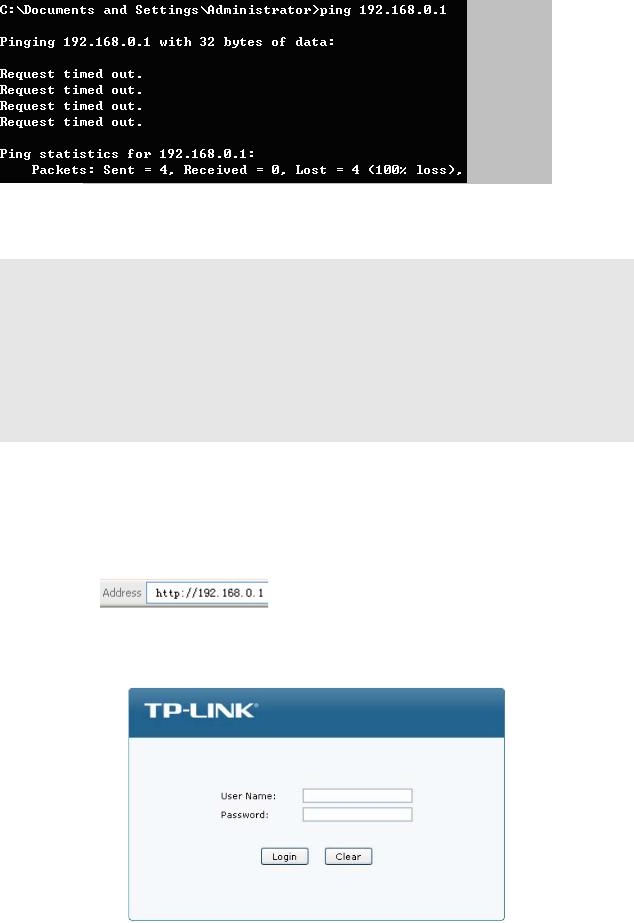
Figure 3-6
You can check it by following the steps below:
 Note:
Note:
●Is the connection between your PC and the router correct?
The LEDs of LAN port which you link to the device and the LEDs on your PC's adapter should be lit.
●Is the TCP/IP configuration for your PC correct?
If the router's IP address is 192.168.0.1, your PC's IP address must be within the range of 192.168.0.2 ~ 192.168.0.254, the gateway must be 192.168.0.1.
3.2 Login
Once your host PC is properly configured, please proceed as follows to use the Web-based Utility: Start your web browser and type the private IP address of the router in the URL field: http://192.168.0.1.
After that, you will see the screen shown below; enter the default User Name admin and the default Password admin.
Figure 3-7
-11-
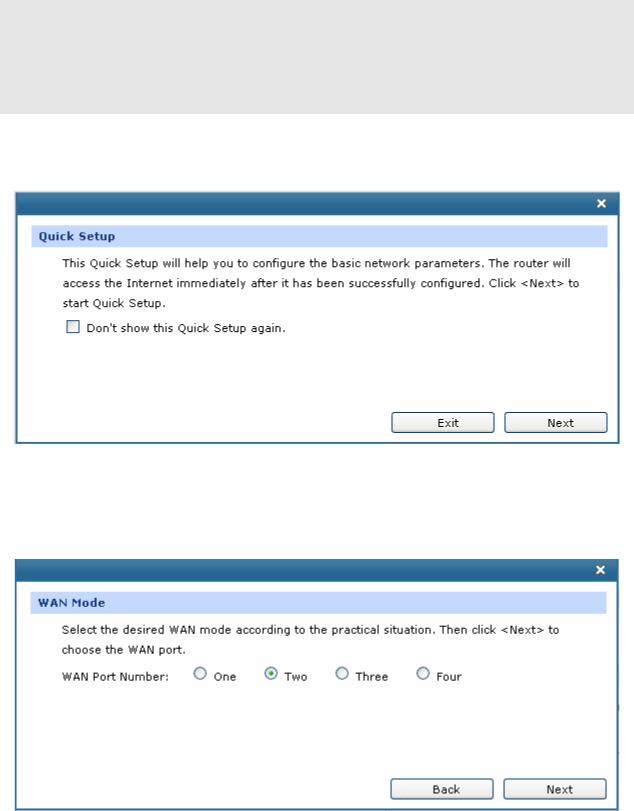
 Note:
Note:
If the above screen (Figure 3-7) does not prompt, it means that your web-browser may be set to a proxy. Choose Tools menu→Internet Options→Connections→LAN Settings, in the screen that appears, cancel the Using Proxy checkbox, and click OK to finish it.
After a successful login, the “Quick Setup” screen will pop up as the Figure 3-8 shows. If it does not prompt, you can click the Quick Setup on the left of the main menu. Then click <Next>.
Figure 3-8 Quick Setup
Select the total number of WAN ports you prefer to use as the Figure 3-9 shows. Then click <Next> to load the WAN Port screen.
Figure 3-9 WAN Mode
Select the WAN port you want to use as the Figure 3-10 shows, and then click <Next> to load the WAN Connection Type screen.
-12-
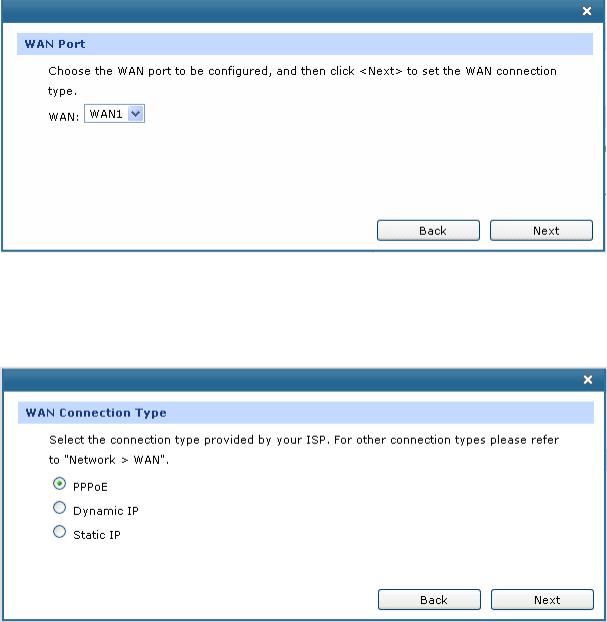
Figure 3-10 WAN Port
Select the connection type provided by your ISP as the Figure 3-11 shows. Three popular types are provided here. For other connection types, please refer to the 4.3.1 WAN.
Figure 3-11 WAN Connection Type
1)If you choose PPPoE, you will see the screen as the Figure 3-12 shows. Enter the Account Name and Password provided by your ISP (Internet Service Provider).
-13-
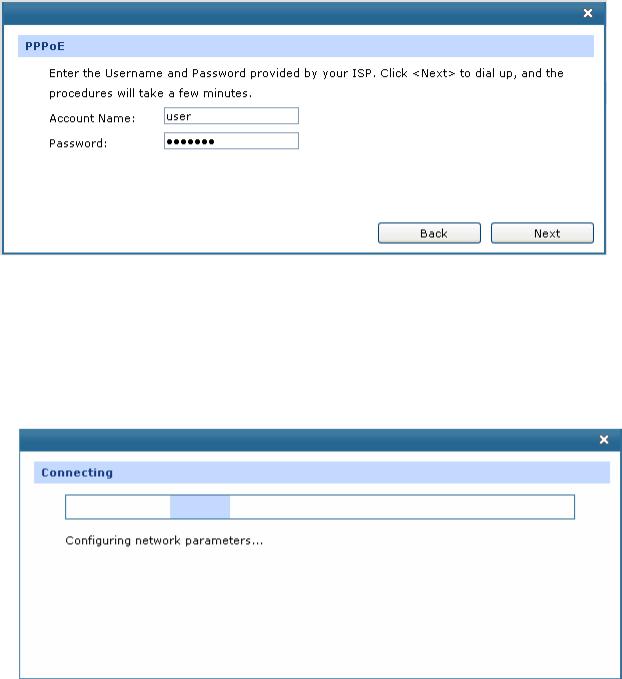
Figure 3-12 WAN Connection Type - PPPoE
Click <Next> to dial up, and the process will take a few minutes. The process of configuring the network parameters is shown as Figure 3-14. If you close the screen during the process, the configuration will still be continued in the background.
These fields are case sensitive. If you have difficulty in this process, please contact your ISP.
Figure 3-13 WAN Connection Type – PPPoE Connecting
2)If your ISP assigns the IP address automatically, please choose the Dynamic IP connection type to obtain the parameters for WAN port automatically. The process for obtain the parameter may take a few minutes as Figure 3-14 shows. If you close the screen during the process, the configuration will still be continued in the background.
-14-
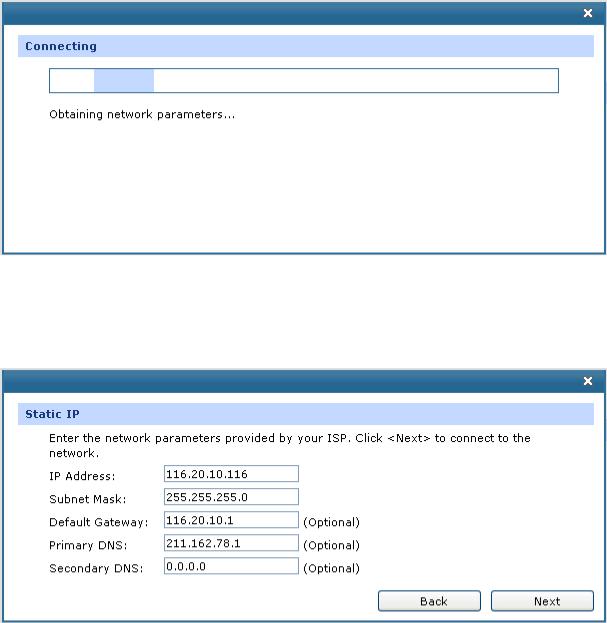
Figure 3-14 WAN Connection Type - Dynamic IP
3)If you choose Static IP, you should enter the detailed IP information provided by your ISP in Figure 3-15.
Figure 3-15 WAN Connection Type - Static IP
Then click <Next>. The process for configuring the network parameters is shown as Figure 3-16. If you close the screen during the process, the configuration will still be continued in the background.
If you have difficulty in this process, please contact your ISP.
-15-

Figure 3-16 WAN Connection Type - Static IP Connecting
After that, you will see the next screen. Click <Finish> to complete the quick installation or click <Continue> to configure other WAN ports.
Figure 3-17 Configuration Completed
-16-
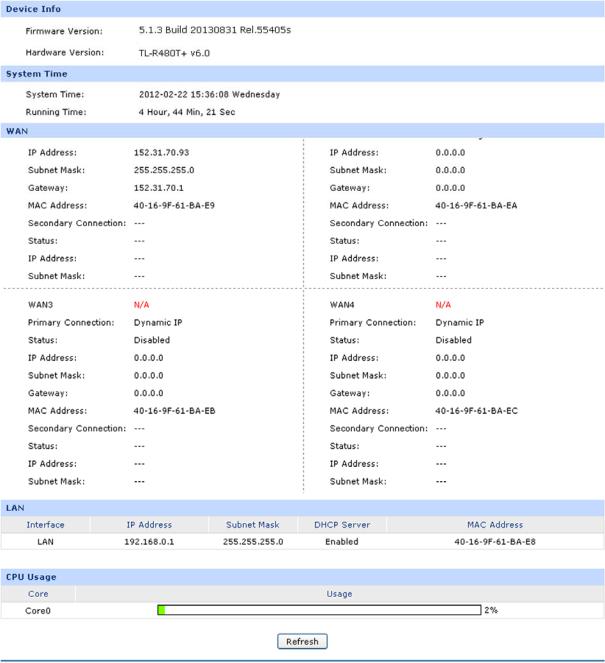
Chapter 4 Configuration
4.1 Status
The Status page shows the system information, the port connection status and other information related to this router.
Choose the menu Status to load the following page.
Figure 4-1 Status
-17-
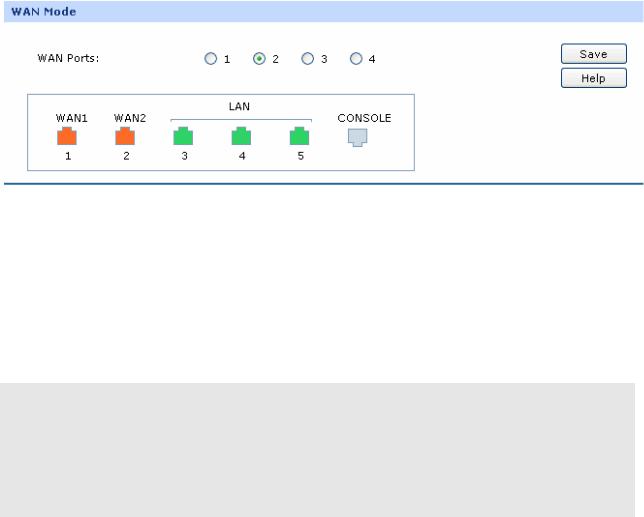
4.2 Quick Setup
Please refer to the Chapter 3 Quick Installation Guide.
4.3 Network
4.3.1 WAN
4.3.1.1WAN Mode
TL-R480T+ provides four available WAN ports. You can set the number of WAN ports on this page.
Choose the menu Network→WAN→WAN Mode to load the following page.
Figure 4-2 WAN Mode
¾WAN Mode
WAN Ports: Select the total number of WAN ports you prefer to use. And the router will adjust the physical ports accordingly, which can be illustrated on the following port sketch.
 Note:
Note:
●By default, TL-R480T+ is set to work in the mode of dual WAN ports.
●Any change to the number of WAN ports may lead to a loss of current configurations. Please be sure to backup your configurations in advance.
4.3.1.2WAN1
TL-R480T+ provides the following six Internet connection types: Static IP, Dynamic IP, PPPoE/Russian PPPoE, L2TP/Russian L2TP, PPTP/Russian PPTP and BigPond. To configure the WAN, please first select the type of Internet connection provided by your ISP (Internet Service Provider).
-18-
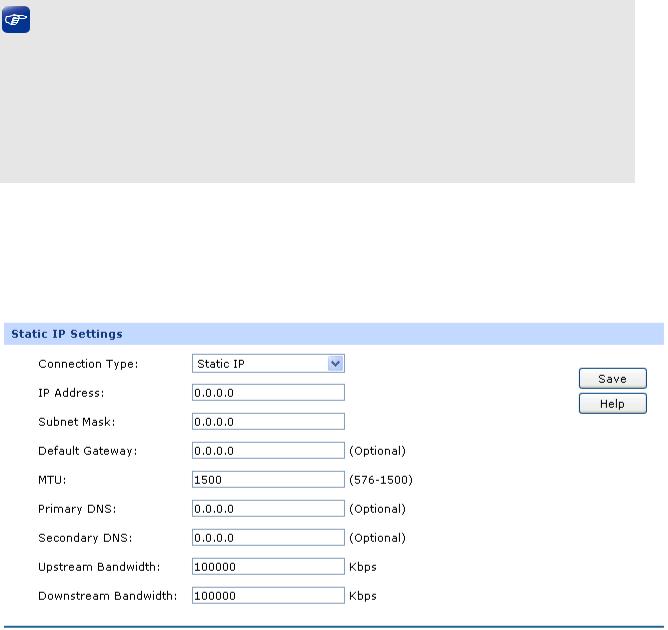
Tips:
●It’s allowed to set the IP addresses of multiple WAN ports within the same subnet. However, to guarantee a normal communication, make sure that the WAN ports can access the same network, such as Internet or a local area network.
●The amount of tab pages for WAN port varies with the number of the WAN ports. For the configurations of the other WAN ports, please refer to the instructions of WAN1.
Choose the menu Network→WAN→WAN1 to load the configuration page.
1)Static IP
If a static IP address has been provided by your ISP, please choose the Static IP connection type to configure the parameters for WAN port manually.
Figure 4-3 WAN – Static IP
The following items are displayed on this screen:
¾Static IP
Connection Type: Select Static IP if your ISP has assigned a static IP address for your computer.
IP Address: Enter the IP address assigned by your ISP. If you are not clear, please consult your ISP.
Subnet Mask: Enter the Subnet Mask assigned by your ISP.
-19-
Default Gateway: |
Optional. Enter the Gateway assigned by your ISP. |
MTU: |
MTU (Maximum Transmission Unit) is the maximum data unit |
|
transmitted by the physical network. It can be set in the range of |
|
576-1500. The default MTU is 1500. You are recommended to keep |
|
the default value if no other MTU value is provided by your ISP. |
Primary DNS: |
Enter the IP address of your ISP’s Primary DNS (Domain Name |
|
Server). If you are not clear, please consult your ISP. It’s not allowed |
|
to access the Internet via domain name if the Primary DNS field is |
|
blank. |
Secondary DNS: |
Optional. If a Secondary DNS Server address is available, enter it. |
Upstream Bandwidth: |
Specify the bandwidth for transmitting packets on the port. |
Downstream |
Specify the bandwidth for receiving packets on the port. |
Bandwidth: |
|
2)Dynamic IP
If your ISP (Internet Service Provider) assigns the IP address automatically, please choose the Dynamic IP connection type to obtain the parameters for WAN port automatically.
-20-
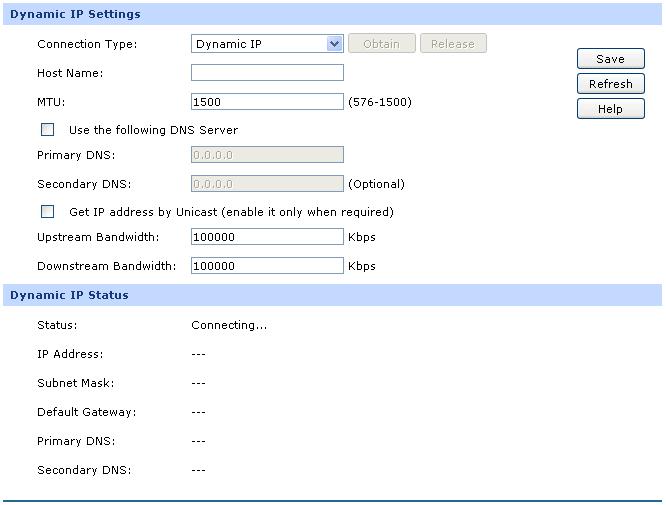
Figure 4-4 WAN – Dynamic IP
The following items are displayed on this screen:
¾Dynamic IP
Connection Type: Select Dynamic IP if your ISP assigns the IP address automatically. Click <Obtain> to get the IP address from your ISP’s server. Click <Release> to release the current IP address of WAN port.
Host Name: Optional. This field allows you to give a name for the router. It's blank by default.
MTU: MTU (Maximum Transmission Unit) is the maximum data unit transmitted by the physical network. It can be set in the range of 576-1500. The default MTU is 1500. You are recommended to keep the default value if no other MTU value is provided by your ISP.
-21-
Get IP Address by |
The broadcast requirement may not be supported by a few ISPs. |
Unicast: |
Select this option if you can not get the IP address from your ISP |
|
even with a normal network connection. This option is not required |
|
generally. |
Use the following DNS |
Select this option to enter the DNS (Domain Name Server) address |
Server: |
manually. |
Primary DNS: |
Enter the IP address of your ISP’s Primary DNS (Domain Name |
|
Server). If you are not clear, please consult your ISP. |
Secondary DNS: |
Optional. If a Secondary DNS Server address is available, enter it. |
Upstream Bandwidth: |
Specify the bandwidth for transmitting packets on the port. |
Downstream |
Specify the bandwidth for receiving packets on the port. |
Bandwidth: |
|
¾ Dynamic IP Status |
|
Status: |
Displays the status of obtaining an IP address from your ISP. |
|
z “Disabled” indicates that the Dynamic IP connection type is not |
|
applied. |
|
z “Connecting” indicates that the router is obtaining the IP |
|
parameters from your ISP. |
|
z “Connected” indicates that the router has successfully obtained |
|
the IP parameters from your ISP. |
|
z “Disconnected” indicates that the IP address has been |
|
manually released or the router gets no response from your |
|
ISP. Please check your network connection and consult your |
|
ISP if this problem remains. |
IP Address: |
Displays the IP address assigned by your ISP. |
Subnet Mask: |
Displays the Subnet Mask assigned by your ISP. |
Gateway Address: |
Displays the Gateway Address assigned by your ISP. |
|
-22- |

Primary DNS: Displays the IP address of your ISP’s Primary DNS.
Secondary DNS: Displays the IP address of your ISP’s Secondary DNS.
3)PPPoE
If your ISP (Internet Service Provider) has provided the account information for the PPPoE connection, please choose the PPPoE/Russian PPPoE connection type (Used mainly for DSL Internet service).
Figure 4-5 WAN - PPPoE
-23-
The following items are displayed on this screen:
¾PPPoE Settings
Connection Type: Select PPPoE/Russian PPPoE if your ISP provides xDSL Virtual
Dial-up connection. Click <Connect> to dial-up to the Internet and obtain the IP address. Click <Disconnect> to disconnect the Internet and release the current IP address.
Account Name: |
Enter the Account Name provided by your ISP. If you are not clear, |
|
please consult your ISP. |
Password: |
Enter the Password provided by your ISP. |
Active Mode: |
You can select the proper Active mode according to your need. |
|
z Manual: Select this option to manually activate or terminate the |
|
Internet connection by the <Connect> or <Disconnect> button. |
|
It’s optimum for the dial-up connection charged on time. |
|
z Always-on: Select this option to keep the connection always |
|
on. The connection can be re-established automatically when it |
|
is down. |
|
z Time-based: Select this option to keep the connection on |
|
during the Active time you set. |
PPPoE Advanced |
Check here to enable PPPoE advanced settings. |
Settings: |
|
Keep Alive: |
Once PPPoE is connected, the router will send keep-alive packets |
|
every "Keep Alive Interval" sec and "Keep Alive Retry Times" to |
|
make sure the connection is still alive. If the router does not get the |
|
response from ISP after sending keep-alive packets, the router will |
|
terminate the connection. |
MTU: |
MTU (Maximum Transmission Unit) is the maximum data unit |
|
transmitted by the physical network. It can be set in the range of |
|
576-1492. The default MTU is 1480. You are recommended to keep |
|
the default value if no other MTU value is provided by your ISP. |
-24-
ISP Address: |
Optional. Enter the ISP address provided by your ISP. It's null by |
|
default. |
Service Name: |
Optional. Enter the Service Name provided by your ISP. It's null by |
|
default. |
Primary DNS: |
Enter the IP address of your ISP’s Primary DNS. |
Secondary DNS: |
Optional. Enter the IP address of your ISP’s Secondary DNS. |
Secondary Connection: |
Here allows you to configure the secondary connection. Dynamic IP |
|
and Static IP connection types are provided. |
Connection Type: |
Select the secondary connection type. Options include Disable, |
|
Dynamic IP and Static IP. |
IP Address: |
If Static IP is selected, configure the IP address of WAN port. If |
|
Dynamic IP is selected, the obtained IP address of WAN port is |
|
displayed. |
Subnet Address: |
If Static IP is selected, configure the subnet address of WAN port. If |
|
Dynamic IP is selected, the obtained subnet address of WAN port is |
|
displayed. |
Status: |
Displays the status of secondary connection. |
Upstream Bandwidth: |
Specify the bandwidth for transmitting packets on the port. |
Downstream Bandwidth: |
Specify the bandwidth for receiving packets on the port. |
-25-
